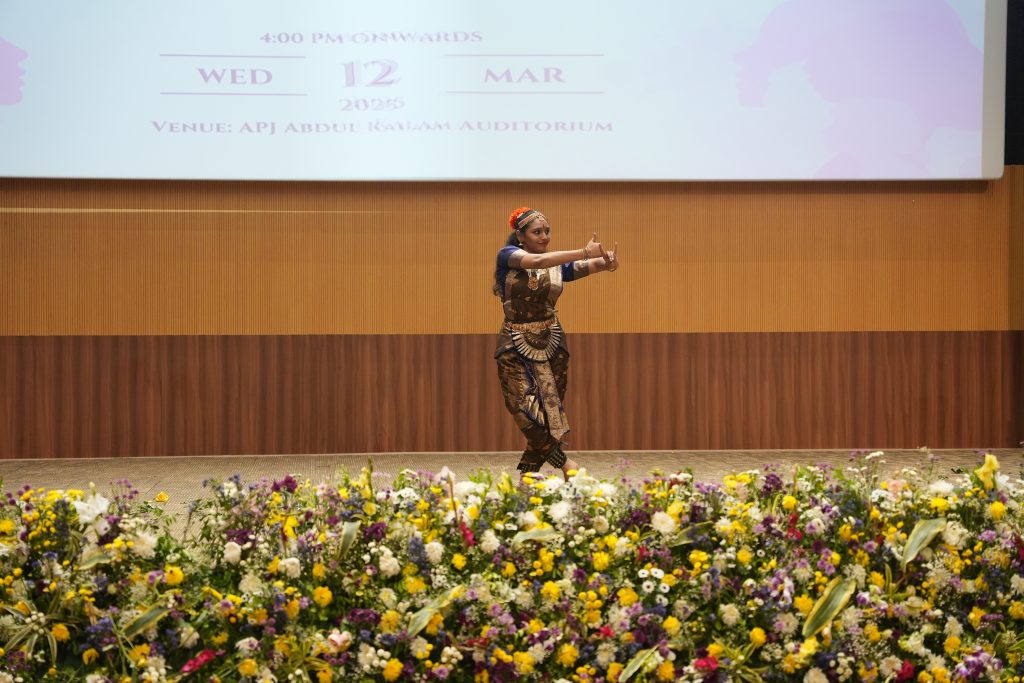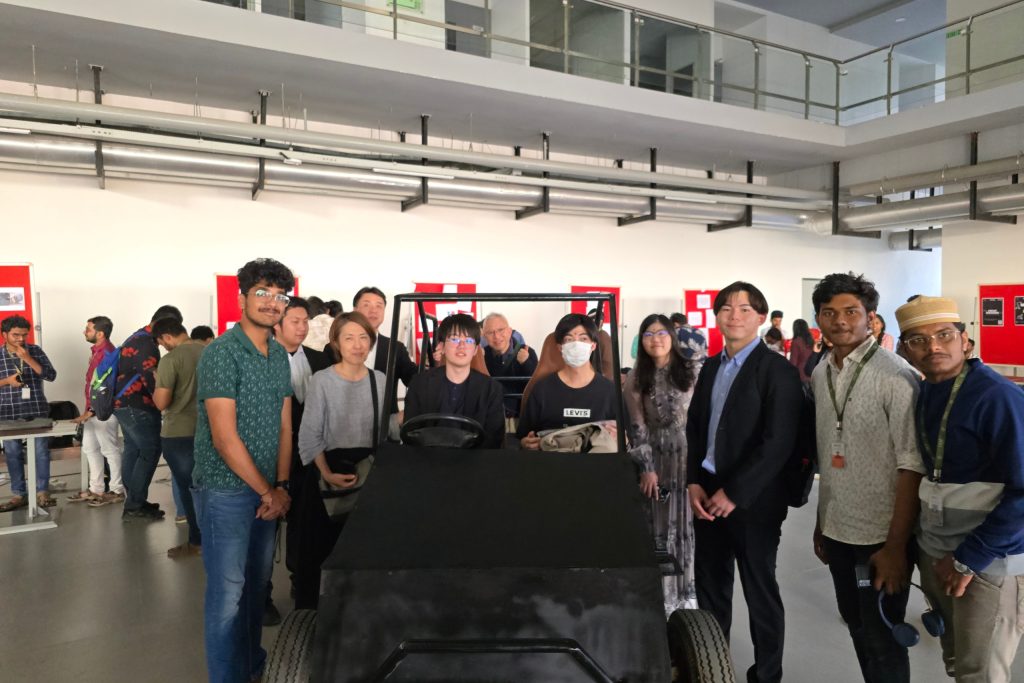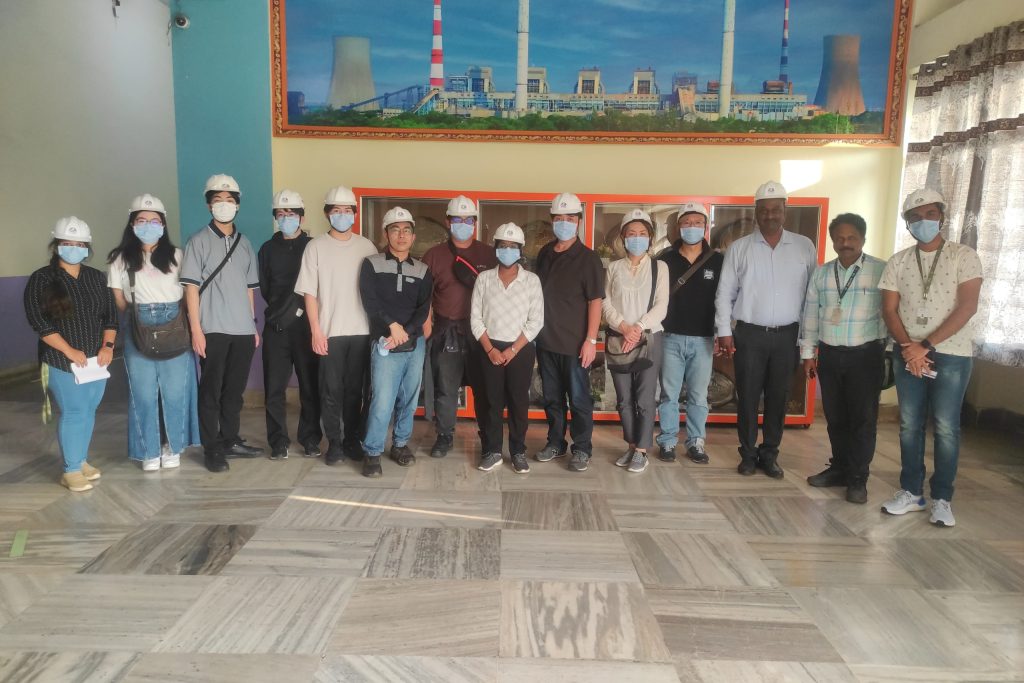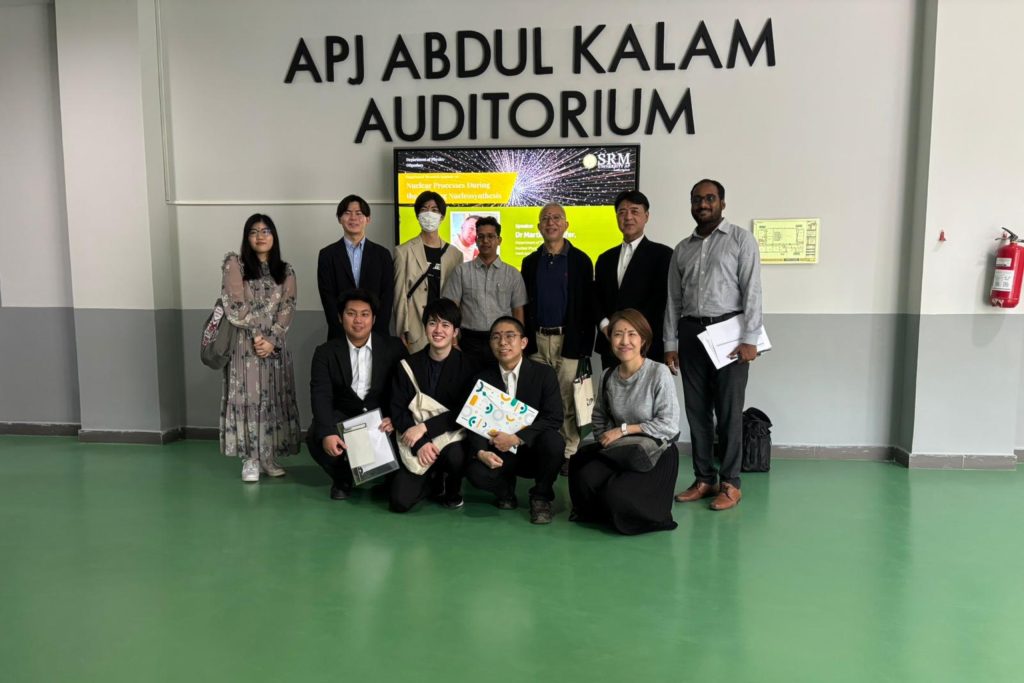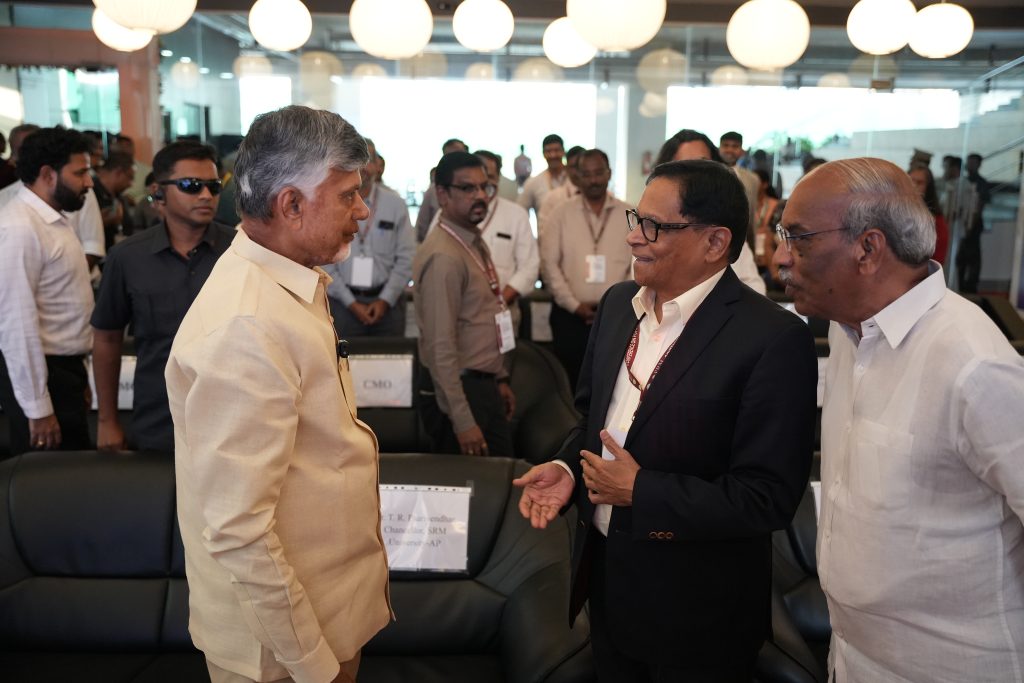All Management Events
- Celebrating Women: SRM AP Observes International Women’s Day March 17, 2025
 Smt. Madhuri Nallapaneni, Group Director, Cadence-Invecas India graced the International Women’s Day celebration held at SRM University-AP. The celebration was organised by the Directorate of Student Affairs and featured esteemed dignitaries including SRM Group Advisor Prof. V S Rao alongside Vice Chancellor Prof. Manoj K Arora; Registrar Dr R Premkumar; Associate Directors Ms Revathi Balakrishnan and Dr Ramesh Vaddi; Deans of the 3 schools, Directors, Faculty, Staff and students.
Smt. Madhuri Nallapaneni, Group Director, Cadence-Invecas India graced the International Women’s Day celebration held at SRM University-AP. The celebration was organised by the Directorate of Student Affairs and featured esteemed dignitaries including SRM Group Advisor Prof. V S Rao alongside Vice Chancellor Prof. Manoj K Arora; Registrar Dr R Premkumar; Associate Directors Ms Revathi Balakrishnan and Dr Ramesh Vaddi; Deans of the 3 schools, Directors, Faculty, Staff and students.Vice Chancellor Prof. Manoj K Arora in his address stated, “A woman in her lifetime assumes many roles, the role of a mother, daughter, wife, sister, friend, a daughter-in-law, a mother-in-law and more. She is the ‘Janani’ (nurturer) and deserves utmost respect.”
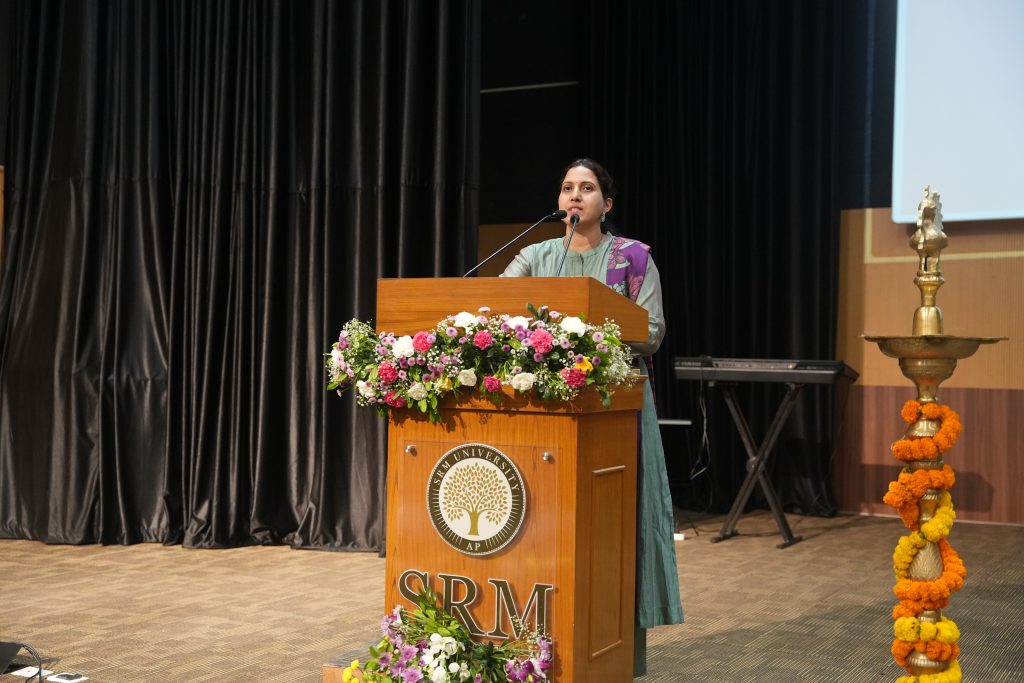
He also referenced the recent conference on Population Dynamics, wherein the concept of population management emphasised the welfare of women to effectively manage population. Prof. Arora also stressed on the theme of this year’s women’s day celebration – “Accelerate Action”.
During her address, Ms Nalapaneni remarked that, “Women’s day celebration should not be just that, beyond mere celebration it should be a checkpoint for us to analyse the challenges women face and to overcome them.” She also added, our precursors have paved the way for us to be here today. She encouraged everyone present to be a lifetime learner, because life never stops teaching.
Ms Nalapaneni empahsised the need to continue advocating for women’s empowerment and support other women because when a woman is empowered the entire society is empowered. The celebration featured several engaging games including tug of war, push-up challenge, debate competition, cooking without fire and arm wrestling. The winners of the competition were felicitated.
 The competition winners were presented with certificates. The highlight of the celebration was the presentation of the Uttama Mahila Prathibha Award, an initiative of Advisor Prof. V S Rao Foundation. The awards were presented across various categories such as landscaping, security, mess and so on. The event also featured a heart touching video featuring the women of SRM AP and honouring their achievements and contributions.
The competition winners were presented with certificates. The highlight of the celebration was the presentation of the Uttama Mahila Prathibha Award, an initiative of Advisor Prof. V S Rao Foundation. The awards were presented across various categories such as landscaping, security, mess and so on. The event also featured a heart touching video featuring the women of SRM AP and honouring their achievements and contributions.SRM University-AP remains committed to empowering women and looks forward to organising more events that celebrate and support women’s contributions within the community.
Continue reading → - SRM AP Hosts Annual Management Flagship Event on Work life Balance March 17, 2025
The New Indian Express
Continue reading →

The Pioneer

The South India Times

The Hans India
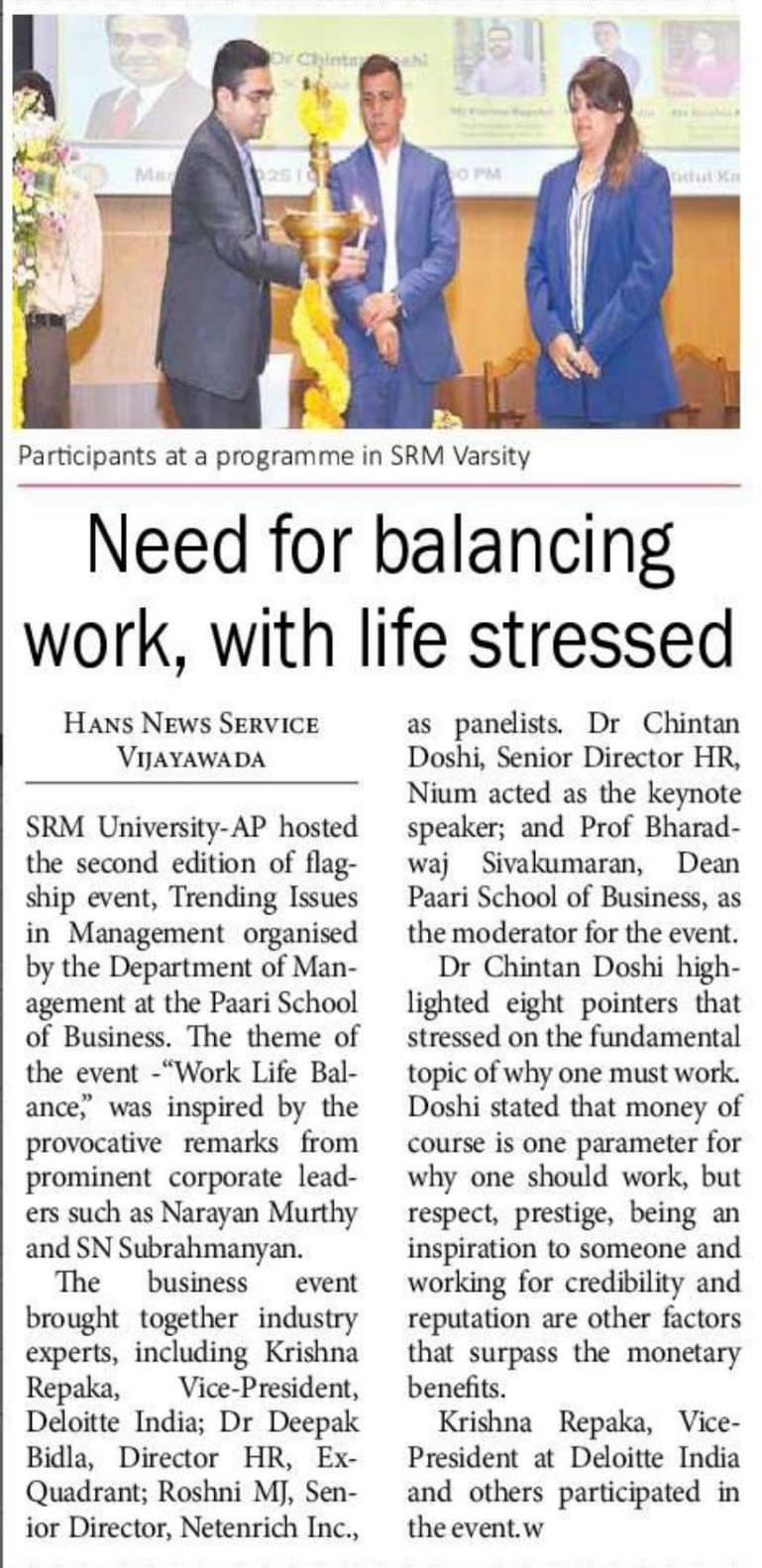
- Discover India 2025: SRM AP Hosts Japanese Delegation March 13, 2025
 The Directorate of International Relations & Higher Studies welcomed the students and faculty from Nihon University and Forum Engineering, Japan to the “Discover India 2025” programme.
The Directorate of International Relations & Higher Studies welcomed the students and faculty from Nihon University and Forum Engineering, Japan to the “Discover India 2025” programme.A 4-day event, the Discover India 2025 programme conducted by the Directorate of International Relations and Higher Studies was inaugurated by the honourable Vice Chancellor of SRM University-AP, Prof. Manoj K Arora, in the presence of Prof. C V Tomy, Dean – School of Engineering and Sciences; Prof. Vishnupad, Dean – Easwari School of Liberal Arts; Dr Raviteja KVNS, Assistant Professor & Head-Department of Civil Engineering; Prof. P Vivekananda Shanmuganathan, Professor-Mechanical Engineering; and Dr Pranav R T Peddinti, Assistant Professor-Department of Civil Engineering. “Discover India 2025” is a flagship initiative of the university to promote India’s cultural and knowledge traditions.
Dr Sudeshna Saha, Assistant Director of International Relations and Higher Studies, received the international students at the grand inaugural ceremony of the programme. Students participated in various short courses on research area introduction Mechanical Engineering/ Lab and Centre Visit, Electronic Cooling Lab, Computer Science and Engineering and visit to Research Lab’s, Civil Engineering Labs and Drone and Geospatial technologies. Dr Pranav R T Peddinti and Mr Balu from the department of Civil Engineering gave presentations on Robotics and Prof. Vivekanandan from the Department of Mechanical Engineering offered an overview on Additive Manufacturing & Bio Printing Materials.
Discussion were held with the IR & HS team and with the leadership team regarding various mobility programmes, including Student and Faculty Exchange, Transfer Programmes, Joint Research initiatives, and opportunities for mutual collaboration between Nihon University and SRM University-AP.
An interactive session was organised for Destination Japan students who are currently learning Japanese at SRM University-AP. Prof. Toriizuka Takashi & Prof. Kamei Yasuko delivered an engaging presentation on Nihon University, highlighting job and internship opportunities in Japan. The session provided a platform for Destination Japan students to interact with peers learning Japanese. Over 63 students actively participated, making the event a resounding success.
The industrial visit saw participation from a total of 13 members, including 2 professors, 1 staff member , and 6 students from Nihon University and Forum Engineering, as well as 2 staff members and 2 students from SRM University-AP. As part of the “Discover India” programme, SRM University AP organised an industrial visit on February 06, 2025, for the Japanese delegation from Nihon University and Forum Engineering. The group visited the Dr Narla Tata Rao Thermal Power Station in Ibrahimpatnam. The power plant is one of the coal-based power plants of APGENCO.
The visit began with a brief introduction of the team, followed by a presentation on the Ibrahimpatnam Coal-Based Power Station. After the presentation, the group toured the entire power station, including the coal heating and cooling units, gaining an understanding of the coal-based power generation process and how electricity is supplied to the Vijayawada region.
Continue reading → - Revolutionize Your Approach: The Design Thinking Blueprint March 12, 2025
The Tribune
Continue reading →

Newsvoir

The Print

- Generative AI Revolutionizing Supply Chains: A New Era of Efficiency, Resilience, and Sustainability March 12, 2025
The Indian Bulletin
Continue reading →

Republic News India

Indian Sentinal

Abhyudhay Times

RD Times

- The Unfinished Battle Against Ragging in India March 12, 2025
- Andhra Pradesh’s IT Policy 2024-2029: A Game Changer March 12, 2025
- Honourable Chief Minister of AP Applauds SRM AP on Infrastructure Planning & Augmentation March 12, 2025

“SRM University-AP is a proof of concept of a visionary state, similar to Hitech Hyderabad a proof of united Andhra.” – Honourable Chief Minister of Andhra Pradesh, Shri Nara Chandrababu Naidu
SRM University-AP had the privilege of welcoming the Honourable Chief Minister of Andhra Pradesh, Shri Nara Chandrababu Naidu on campus on March 11, 2025. The Honourable CM, who visited the campus as the chief guest of the Conference of Population Dynamics and Development, organised under the auspices of the Planning Department, Government of Andhra Pradesh, held an exclusive interaction with the leadership and management of SRM University-AP on infrastructure planning, development and execution of the upcoming projects.
The leadership team of SRM AP, headed by the Chancellor Dr T R Paarivendhar, Pro-Chancellor Dr P Sathyanarayanan, Vice Chancellor Prof. Manoj K Arora, Executive Director – Research, SRM Group of Institutions, Prof. D Narayana Rao and Registrar, Dr R Premkumar, showcased the exemplary growth of the university emphasising the establishment of various new-age infrastructure and facilities catering to foster a future-ready academic community.
Prof. D Narayana Rao presented the Honourable CM with the university infrastructure planning and development plan and execution period for the same in the upcoming years. He gave a comprehensive overview of the future projects, including the proposed Centre for Green Hydrogen & Clean Energy Innovation, Centre for Quantum Computing, Centre for Interplanetary Exploration, SRM Medical College, AI Institute, Skilling Academy, etc. Prof. Rao assured that SRM AP would strive towards becoming a centre for transformative learning, research innovations and a successful startup incubator and sought the required support from the Government, by allocating the required resources.
In his interaction with the Honourable CM, Chancellor Dr T R Paarivendhar stated, “We follow our respected Chief Minister Shri Chandrababu Naidu’s vision to transform Amaravati into an innovation hub, and Green Co. SRM University-AP as a new-age holistic university align our strategic goals for development in cognisance to CM’s pioneering vision of Swarn Andhra Vision 2047.”

The Honourable CM congratulated the apex team of the university on its outstanding progress in the seven years, paving the path of learning and growth in Andhra Pradesh. He opined that the future is Internet of Things, Quantum Computing and Green Energy. With SRM AP being a leader in tertiary education, he advised that the university develop a strong workforce of designers, coders, and experts with skills in algorithms and hardware who are pivotal in building a progressive state. The Honourable CM recommended SRM AP to lead the startup ecosystem and produce more entrepreneurs by establishing a dedicated Centre for Innovation and Startup ecosystem.
The Honourable CM inaugurated two newly constructed buildings at SRM AP: C V Raman Block and Ganga Hostel Block (Residential facility for students). In addition, the Honourable CM laid the foundation stones for four new buildings: Industrial Research Park, Academic Cluster, Ganga-B Hostel Block, and Vedavathi-II Hostel Block.
The distinguished visit from the Honourable Chief Minister Shri Chandrababu Naidu is a testament to the relentless support and visionary direction he has offered to SRM University-AP throughout the years. Pro-Chancellor Dr P Sathyanarayanan remarked, “The perceptive insights of the Honourable Chief Minister on SRM University-AP’s initiatives and prospects have aided in aligning our development plans with the objectives of national education.”
SRM AP has made remarkable progress in its infrastructural, academic, and institutional student placement record. The unwavering support and resources from the Government of Andhra Pradesh encourage the university to become globally connected, regionally transformative, and nationally relevant.
Continue reading → - Honourable Chief Minister of AP Applaud SRM University-AP on Infrastructure Planning & Augmentation March 12, 2025
The Hindu
Continue reading →

Deccan Chronicle


Times of India



The Hans India

The New India Express

The Financial Express

The Pioneer

Eenadu

Andhra Jyoti


Andhra Patrika


Andhra Prabha

Visalaandhra

Arth Prakash

- Arun Kumar Sivapuram March 11, 2025



